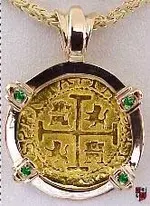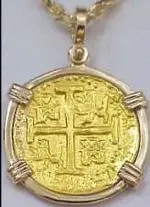cuzcosquirrel
Hero Member
About 4 mm and worked down to about 1.5 mm. It was about as thin as a Seville coin in the end. The gold is about 14 kt. I did three anealings, when I started to see small cracks. I also flattened during the last anealing.
Yeah, they had a lot of square planchette ones too, which would have been produced by flat striking lumps of silver, maybe with a trip hammer, or using a straight-edged trip shear on a flattened length of silver bar. Maybe they had several production process lines, and used them at one time or another for reasons unknown.
They would have had to have melted down the big bars into thinner, flatter sheets, to save energy and time, and to be able to feed them through a roller processing stage. I think I remember the Florida gold book talking about how the gold coins were rolled out in this way.
The shavings, or sweepings produced by the process of cutting blanks posed theft problems from what I have read from historical accounts, as there were always attempts to steal these. The Mexico mint was the most ordered, with a set of regulations described what they could and could not do during coin production. The small o above the M on the Mexico city coins signifys this distinction.
If you look at the Mexico Mint site, they have some nice products, including the 8 reals watch. Also on the site are pictures of several dies, from completed dies to the reverse dies used to make the lion and castle punches on cobs.
Yeah, they had a lot of square planchette ones too, which would have been produced by flat striking lumps of silver, maybe with a trip hammer, or using a straight-edged trip shear on a flattened length of silver bar. Maybe they had several production process lines, and used them at one time or another for reasons unknown.
They would have had to have melted down the big bars into thinner, flatter sheets, to save energy and time, and to be able to feed them through a roller processing stage. I think I remember the Florida gold book talking about how the gold coins were rolled out in this way.
The shavings, or sweepings produced by the process of cutting blanks posed theft problems from what I have read from historical accounts, as there were always attempts to steal these. The Mexico mint was the most ordered, with a set of regulations described what they could and could not do during coin production. The small o above the M on the Mexico city coins signifys this distinction.
If you look at the Mexico Mint site, they have some nice products, including the 8 reals watch. Also on the site are pictures of several dies, from completed dies to the reverse dies used to make the lion and castle punches on cobs.







